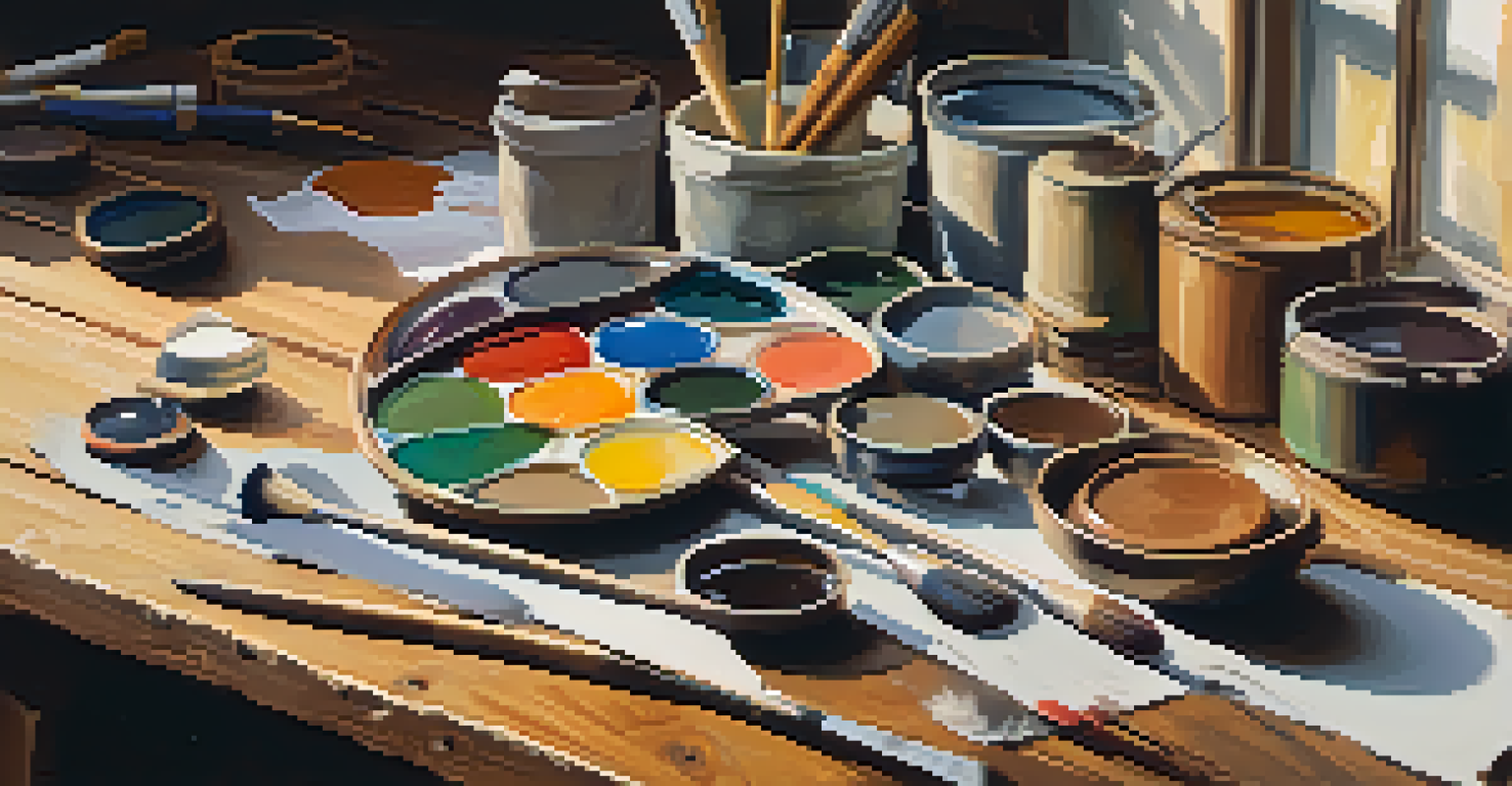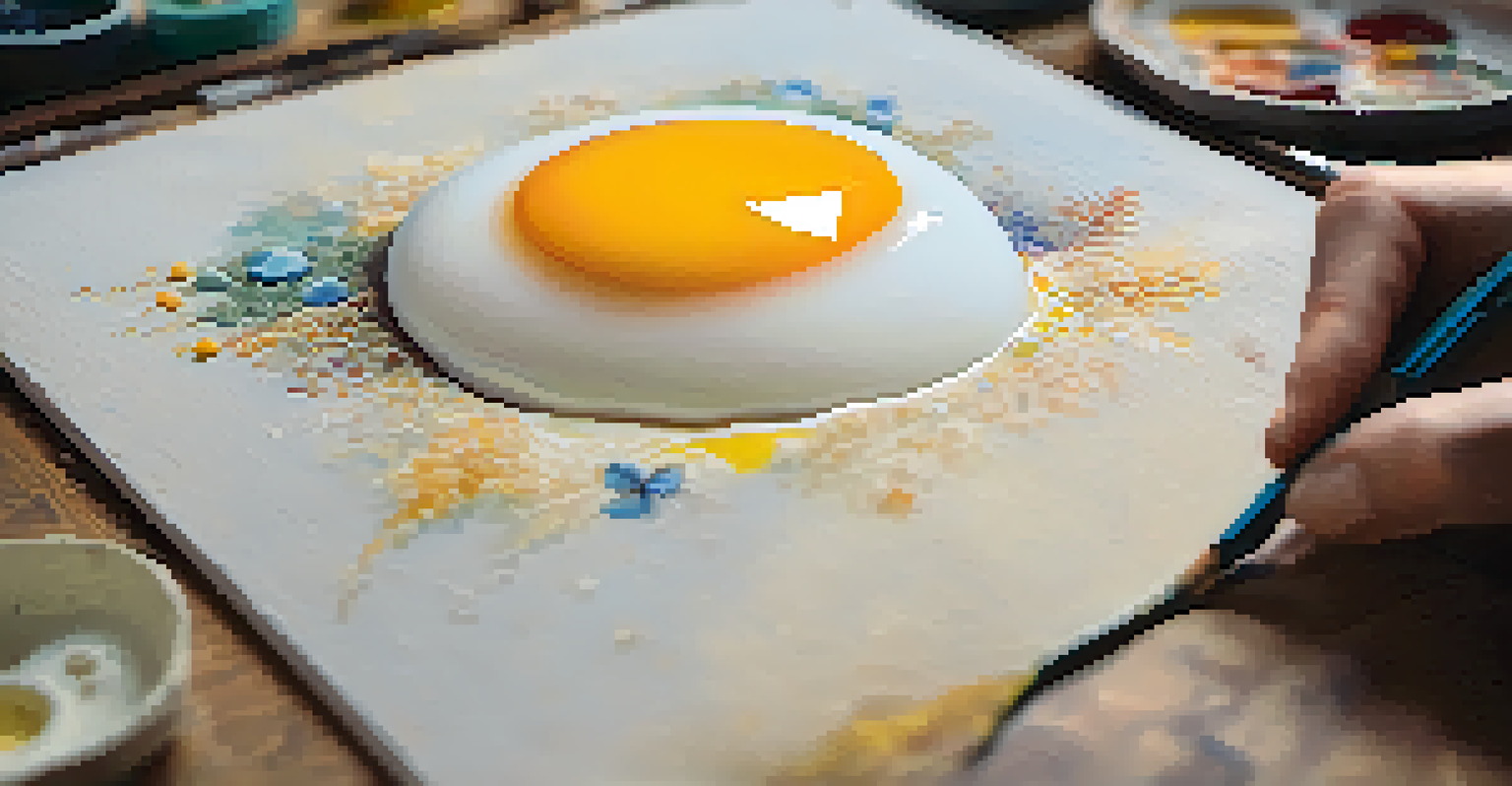Understanding the Ingredients of Traditional Tempera Paint

What is Tempera Paint? A Brief Overview
Tempera paint, often associated with the Renaissance, has a rich history that captivates artists even today. It’s known for its vibrant colors and quick-drying properties, making it a favorite among both amateur and professional painters. Unlike oil paints, which can take days to dry, tempera allows for faster layering and detail work.
Art is not freedom from discipline, but disciplined freedom.
The beauty of tempera lies in its simplicity and the natural materials used in its formulation. Traditionally, artists created tempera paint by mixing pigments with a binding agent, often egg yolk, which gives it a unique texture and finish. This combination not only affects the paint’s appearance but also how it behaves on different surfaces.
As we delve deeper into its ingredients, we will uncover the magic behind tempera paint and how each component contributes to its iconic qualities. Understanding these ingredients helps artists appreciate the craft and technique involved in this timeless medium.
The Role of Pigments in Tempera Paint
Pigments are the heart of tempera paint, providing the rich colors that artists cherish. These colorants can be derived from natural sources, such as minerals or plants, or they can be synthetic. Each pigment has unique properties that affect the vibrancy, transparency, and lightfastness of the paint.

For instance, earth pigments, like ochres and umbers, offer muted tones and excellent opacity, while synthetic pigments can produce brighter and more vivid colors. When artists select pigments, they often consider how these colors interact with light and how they will appear when mixed with the binder.
Tempera Paint: A Vibrant Tradition
Tempera paint, with its rich history and natural ingredients, offers artists vibrant colors and quick-drying properties for versatile creativity.
Ultimately, the choice of pigment can transform a painting's overall mood and impact. By understanding the qualities of various pigments, artists can make informed decisions that enhance their creative expression through tempera paint.
Understanding the Binder: Egg Yolk in Tempera
The binder in tempera paint is crucial because it holds the pigment particles together and ensures they adhere to the painting surface. Traditionally, egg yolk serves as the primary binder, offering a unique blend of flexibility and durability. This natural binder not only enhances the paint's texture but also affects the drying time and finish.
The painter tries to master the colors, but the colors already contain the painter's spirit.
When mixed with water and pigment, egg yolk creates a creamy consistency that allows for smooth application. It also contributes to the glossy finish that tempera paint is known for, setting it apart from other mediums. However, artists must use the right proportions to avoid issues like cracking or a dull appearance.
Understanding how egg yolk interacts with pigments helps artists manipulate the paint's properties effectively. By mastering this relationship, they can achieve the desired results in their artwork, whether they aim for a matte or a shiny finish.
Water: The Key to Mixing Tempera Paint
Water plays an essential role in the mixing and application of tempera paint. It acts as a solvent that allows the binder to blend seamlessly with the pigments, creating a usable paint consistency. The amount of water added can influence the paint's opacity and transparency, giving artists control over their desired effects.
Adding too much water can lead to a watery consistency that may not adhere well to the surface. Conversely, using too little water can make the paint difficult to spread and blend. Finding the right balance is vital for achieving the ideal texture and flow during painting.
Pigments Shape Artistic Expression
The choice of pigments in tempera paint significantly influences the vibrancy and mood of a painting, allowing artists to enhance their creative expression.
By experimenting with different water ratios, artists can discover unique techniques and styles. This flexibility makes tempera paint an exciting medium for both beginners and seasoned artists alike.
Additives: Enhancing Tempera Paint Performance
In addition to the primary ingredients, artists often use various additives to improve the performance of tempera paint. Common additives include glycerin, which increases the paint's fluidity, and sugar, which can enhance adhesion. These ingredients help customize the paint for specific techniques or effects.
For example, adding a small amount of glycerin can help keep the paint workable for longer periods, which is particularly useful for detailed work. Alternatively, sugar can provide a smoother finish and improve the paint's overall durability on the canvas.
Understanding how these additives influence the paint can empower artists to experiment and push the boundaries of their creativity. With the right combination of ingredients, tempera paint can be tailored to suit any artistic vision.
Surface Preparation: The Impact on Tempera Paint
The surface on which tempera paint is applied can significantly impact its overall appearance and longevity. While tempera can be used on various surfaces, such as wood, paper, or canvas, each material requires specific preparation to achieve the best results. Properly priming the surface ensures that the paint adheres well and maintains its vibrancy over time.
For instance, when working on paper, it’s essential to choose a heavy-weight, textured paper that can handle the moisture from the paint. On wooden panels, a gesso primer can create a smooth, stable surface that allows the colors to pop. Without adequate preparation, artists may find that their paint cracks or fades prematurely.
Surface Preparation is Crucial
Properly preparing the painting surface ensures that tempera paint adheres well and retains its vibrancy over time, impacting the overall quality of the artwork.
Thus, understanding the relationship between tempera paint and its surfaces is critical for successful painting. A well-prepared surface not only enhances the paint's application but also contributes to the overall quality of the finished artwork.
The Benefits of Using Traditional Tempera Paint
Embracing traditional tempera paint comes with a myriad of benefits that appeal to artists seeking a more organic approach. For one, the natural ingredients used in tempera paint are often non-toxic and safe to handle, making it an excellent choice for artists of all ages. This aspect aligns well with the growing trend of eco-friendly art practices.
Additionally, tempera paint offers exceptional color vibrancy and versatility, allowing artists to create everything from fine details to broad washes. Its ability to layer effectively means artists can achieve complex textures and depth in their work, all while enjoying a fast-drying medium that encourages spontaneity.

Ultimately, using traditional tempera paint can enrich the artistic experience, providing a connection to historical techniques while fostering innovation. As artists explore this medium, they discover not only its beauty but also the joy of working with time-honored materials.